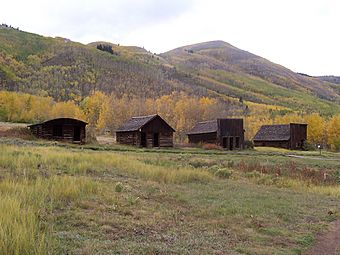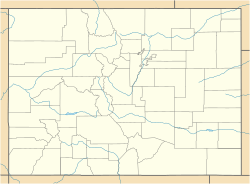Ashcroft, Colorado facts for kids
Quick facts for kids |
|
|
Ashcroft, Colorado
|
|

Buildings along Ashcroft's Castle Avenue, 2007
|
|
| Location | Pitkin County, Colorado, United States |
|---|---|
| Nearest city | Aspen |
| Area | 5 acres (2.0 ha) |
| Built | 1879 |
| NRHP reference No. | 75000533 |
| Added to NRHP | May 12, 1975 |
Ashcroft is a famous ghost town in Pitkin County, Colorado, United States. It was once a busy silver mining town. The town started as Castle Forks City in the spring of 1880. It was later called Chloride for a short time before becoming Ashcroft again.
Ashcroft is located about 10 miles (16 km) south of Aspen. It sits high in the mountains at 9,521 feet (2,902 meters) above sea level. Today, a few old buildings still stand, showing what the town was like long ago. On May 12, 1975, Ashcroft was added to the National Register of Historic Places. This means it's an important historical site.
Contents
Ashcroft's Early Days: A Silver Rush Story
How Ashcroft Began
In the spring of 1880, two explorers named Charles B. Culver and W.F. Coxhead left the busy mining town of Leadville. They were searching for silver in the beautiful Castle Creek Valley. They found silver, and Coxhead excitedly shared their discovery back in Leadville.
When Coxhead returned to their new camp, which they called "Castle Forks City," he found 23 more prospectors had joined "Crazy Culver." These men quickly formed a group called the Miners' Protective Association. In just two weeks, they built a courthouse and planned the streets of Ashcroft. Each member paid $5 or worked for a day, plus $1, to choose building lots. There were 97 members in total.
Name Changes and a Big Boom
The Ashcroft post office opened on August 12, 1880. However, it was renamed Chloride on August 5, 1881. Then, on January 3, 1882, the name changed back to Ashcroft. This happened after a lot of rich silver ore was found in the Montezuma and Tam O'Shanter Mines.
These mines were partly owned by H.A.W. Tabor, a very famous miner from Leadville. It's said that Tabor and his wife visited Ashcroft in 1883. They hosted a huge party with a grand ball and a fancy dinner. Tabor even bought drinks for everyone in all 13 of the town's saloons!
Life in a Booming Mining Town
In the same year Tabor visited, Ashcroft's population grew to about 2,000 people. The town had two newspapers, a school, and several sawmills. It even had a small smelter, which is a factory that melts ore to get the metal out. There were also 20 saloons, which were like restaurants and bars.
At this time, Ashcroft was actually bigger than Aspen. It was also closer to the railroad in Crested Butte, which was important for moving goods and people. By 1885, the town had between 2,000 and 3,500 residents, six hotels, and 20 saloons. But just as quickly as the town grew, it started to shrink.
Ashcroft's Decline: From Boom to Ghost Town
Why the Silver Ran Out
The silver that Culver and Coxhead first found was very rich. It produced a lot of silver per ton of rock. However, these rich deposits were not very deep. This meant the silver quickly ran out.
There were promises of a railroad line to Crested Butte, but it never happened. This made it harder for Ashcroft to get supplies and transport its silver. Meanwhile, other places like Aspen started to attract miners and investors. In 1884, a new, very rich silver discovery was made in Aspen. This was the beginning of the end for Ashcroft's prosperity. People began to move to Aspen for better opportunities.
The Last Residents
By 1885, only about 100 people lived in Ashcroft during the summer. The town's money was almost gone. By the early 1900s, only a few older, single men remained. They still owned mining claims but spent most of their time fishing, hunting, or reading and drinking at the local bar. They would share stories for drinks and help each other find the few remaining jobs at the mines. Every four years, these remaining citizens would hold elections and choose town leaders from among themselves.
The Ashcroft post office finally closed on November 20, 1912. The town's very last resident, Jack Leahy, passed away in 1939. This officially made Ashcroft a true ghost town.
Ashcroft's New Life: Skiing, TV, and History
Skiing Dreams and World War II
In the 1930s, people started to show new interest in Ashcroft. Winter sports and the Winter Olympics were becoming popular. An international sportsman named Ted Ryan and his friend Billy Fiske, who was an Olympic bobsled captain, built the Highland-Bavarian Lodge north of Ashcroft. They dreamed of building a European-style ski resort with a special tramway going up to Hayden Peak.
However, World War II stopped their plans. Billy Fiske was killed in the war. Ted Ryan then leased Ashcroft to the U.S. Army for just $1 a year. During the war, the Army's 10th Mountain Division used Ashcroft for mountain training, especially in the summer of 1942. After the war, most of the ski development happened in Aspen, not Ashcroft. Ryan later gave the land to the U.S. Forest Service.
Sled Dogs and a TV Show
In 1948, a World War II veteran named Stuart Mace moved his family and his dog sled team to Ashcroft. Mace was famous for his dog sleds. In 1955, Mace and his Toklat huskies starred in a television series called Sgt. Preston of the Yukon. The ghost town of Ashcroft was even given fake building fronts to look like a Canadian setting for the show, which filmed there until 1958.
Stuart Mace was given 5 acres (20,000 m²) of land to live on. In return, he took care of the remaining buildings and land that Highland-Bavarian still owned in Ashcroft. He spent the rest of his life protecting the area from new buildings and helping the natural environment recover. In 1974, the Aspen Historical Society joined him in this effort. Together, they helped Ashcroft get listed on the National Register of Historic Places in 1975, preserving its history for everyone.
See also
 In Spanish: Ashcroft (Colorado) para niños
In Spanish: Ashcroft (Colorado) para niños



